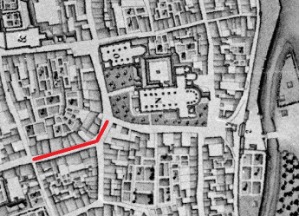
 |
| Fig. 37: Location of the Cortenstraat |
This is an off-street of the Onze Lieve Vrouweplein, where both kortespoelders (‘short rinsers’) and witmakers (‘whitewashers’) probably lived. Kortespoelders were linen weavers, processors of flax and wool. Kortespoelers processed the "short wool", which the ‘gewantmakers’ (weavers of woolen sheets) could not use. It may have been an inferior quality of wool, which was processed by them. The extension of the Cortenstraat is the Witmakersstraat, named after the craft of furriers, but also of plasterers (white plaster workers). In the fourteenth century, a family named Corten lived in the Cortenstraat, more precisely in claustral house no. 4, the first house from the northeast corner of the street. At that time the street was already called Cortenstraat (or a variant, e.g., Platea Corten), so the family name cannot be the namesake of the street name. Cortenstraat certainly does not refer to the length of the street (‘kort’ means short).
 |
| Fig. 53: The Cortenstraat today. |
Reference:
Schaepkens van Riemst, J., “Eenige bijzonderheden omtrent straten, pleinen en bewoners van het oude Tricht”, in: Publications de la Société Historique et Archéologique dans le Limbourg, 43 (1907), 39-369; PSHAL 67 (1931), 187-232; PSHAL 68 (1932), 71-112; PSHAL 69 (1933), 63-86.